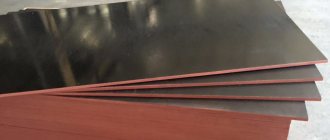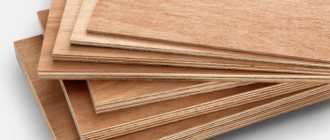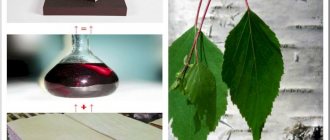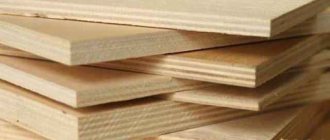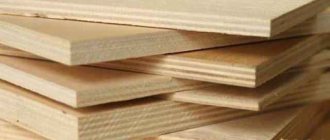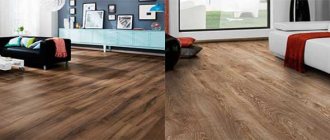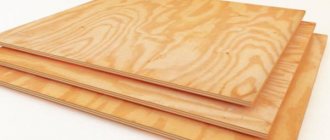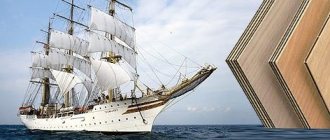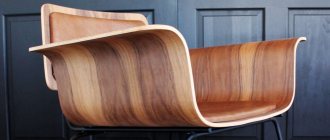Log houses
Dwellings have been built with logs since ancient times; they also remain a popular material now. Log houses have good heat resistance in winter and coolness in hot weather, environmental friendliness, and sound insulation.
Disadvantages: flammability, shrinkage, various types of destruction by external environmental factors, for this it needs to be treated every year from rotting and various kinds of rodents. The cost of log house housing will be 18,000 - 80,000 per m2, depending on the type of wood.
Plywood FSF
Plywood FSF stands for “plywood + resin phenol-formaldehyde glue.” It is a common multi-layer building material that has increased resistance to a humid environment - it is not only moisture-resistant, but also water-resistant. Produced by joining rotary cut veneer. The number of layers is usually odd - from 3 or more. To provide them with excellent strength, sheets are applied by alternating perpendicular and parallel fibers.
Specifications
This type of plywood differs from others not only in its ability to withstand moisture, but also:
- excellent performance;
- quite light weight;
- beautiful texture pattern;
- ease of processing;
- wear resistance;
- increased mechanical strength.
FSF plywood
Therefore, it is recommended for use when more severe conditions than usual are expected - for example, outside the house. The material is technically described by GOST 3916.1-96: it indicates the permissible number of defects and defects on the front side, the appropriate level of wood moisture (usually within 5-10%).
Description of production features
FSF is made by gluing several peeled wood layers (birch, aspen, alder, as well as needles - pine, larch). Each sheet of veneer is joined using a special adhesive impregnation, which is called phenol-formaldehyde resins and gives the plywood waterproof properties, which expands its scope of application.
Gluing of the sheet occurs under strong pressure and is carried out at elevated temperatures. This way the resinous composition softens better and saturates the wood well, penetrating to a sufficient depth. This, in turn, provides excellent traction.
Then the resulting material is cooled, sorted, labeled and sent to the so-called maturation. The final stage is picking several pieces (usually 10 or 20) and packaging.
Varieties
Moisture-resistant plywood is divided into several categories, based on the volume and name of acquired or natural defects:
- E grade;
- I grade;
- II grade;
- III grade;
- IV grade.
Their decoding is simple. The designation “E” means the best group of materials - elite, devoid of any shortcomings and suitable for use in luxury class objects. Further, the quality goes downward, with an increase in the number of possible flaws.
Standard sizes
By purpose, FSF is divided into structural, furniture, packaging, industrial and construction. Based on this criterion, each plywood sheet differs in standard dimensions, which provides additional convenience during calculation and installation.
| Small format | Medium format | Large format |
| 147.5 cm x 147.5 cm | 155 cm x 155 cm | 183 cm x 152.5 cm |
| 127 cm x 127 cm | 152.5 cm x 152.5 cm | 244 cm x 122 cm |
| 122 cm x 122 cm | 152.5 cm x 147.5 cm | 250 cm x 125 cm |
| 152.5 cm x 135 cm | 305 cm x 152.5 cm | |
| 152.5 cm x 127 cm | 300 cm x 150 cm | |
| 152.5 cm x 122 cm |
Plywood size chart
The thickness of the building material varies and depends on the specific application. For laying on the floor, for example, products within 10-12 mm are suitable. In general, the most popular is considered to be 4-21 mm, but there are sheets of greater thickness - up to 40 mm inclusive.
Material for production
Waterproof plywood can be different, because the basis for it is several types of wood, which is pre-peeled into veneer. So, it could be:
- coniferous (from fir, pine, spruce, larch - more often used in the construction industry as a variety of bases);
- deciduous (birch or beech, as well as aspen, maple, alder, hornbeam - used for decorative purposes, for finishing).
But, in essence, other tree species that are widespread in a particular geographic area cannot be excluded. That is, whatever there is more of, FSF is produced from. There is even a pear one.
FSF plywood pack
Suitable lumber is peeled and glued with phenol-formaldehyde resins, which make the plywood able to withstand moisture, as well as mechanical pressure and fracture stress.
Types and markings
Based on the number of layers, it is divided into three basic categories and is:
- multilayer;
- five-layer;
- three-layer.
In general, the sheets contain an odd number of layers so that the veneer runs symmetrically around the middle (the same number comes out on both sides). If their total is even, then the central layers are connected perpendicular to those that run along the outer edges. This adds resistance to deformation and abrasion to the material, as its density increases.
There is another type of separation of sheets: according to the degree of moisture exposure. Having received proper impregnation, they withstand a humid environment even better. Laminated plywood, which literally “rolls” into the laminate, has this property to the maximum, which is why it also becomes flame retardant.
According to the type of surface treatment, FSF can be: polished on both sides (marking Ш2), polished only on one side (marking Ш1) and unpolished (marking Ш).
Areas of application
Due to its excellent technical characteristics, this type of material is widely in demand in several areas:
- construction;
- packaging;
- industrial;
- carriage building;
- radio engineering;
- shipbuilding;
- furniture, etc.
It is used in concrete and roofing processes, is used in automobile and carriage construction, and serves as the basis for large and small packaging containers. Suitable for outdoor use, because it not only resists moisture well, but also nails, drills, and saws well.
vseodereve.ru
Blocks
There are many different types of blocks. The most common foam blocks and gas blocks. Gas blocks and foam blocks have gained great popularity in the construction of private houses in a short time. They have a number of advantages, good heat resistance, sound insulation, lightweight in size compared to other materials, due to this, lower costs for the foundation. Disadvantages: quite fragile, they need to be lined as they quickly absorb moisture due to their porous structure. The cost of a house made of foam blocks will be 11,000 - 20,000 rubles. m2.
FC plywood - grades, sizes, brands
In our time of constant development of building materials, plywood manufacturers could not stop there, although they had already created one of the most popular materials on the planet. Therefore, various modifications of plywood began to appear, which acquired more and more positive and necessary properties. One of these extremely useful modifications in production was FC plywood, the characteristics of which are head and shoulders above the standard version of the material.
What is FC plywood?
General purpose plywood of the FK brand is a waterproof type of material, which, meanwhile, has good environmental safety indicators. FC's direct competitor, FSF plywood, cannot boast of such properties. FSF and FK plywood, the differences of which are quite extensive, are the exact opposite of each other - if the second has average water resistance, but is also environmentally friendly, the first offers extremely high resistance, but threatens its owners with many diseases due to harmful fumes.
The properties of FC plywood are determined by the adhesive mass with which the product is processed. These glues are urea preparations, which are used equally in both softwood and hardwood plywood.
Since FK grade plywood has relatively low moisture resistance, it is mainly used when treating interior walls of a home. The best way to use this material is to treat walls in wet areas - kitchens, bathrooms, showers and saunas. Also, the FC grade of plywood is very often used in the production of furniture, mainly for outdoor use.
The abbreviation FK stands for as follows: K - urea glue, F - plywood. FC plywood, the technical characteristics of which allow the material to be used in a huge list of tasks, has the following main advantages over its competitors:
- it has a standard humidity of five to ten percent;
- waterproof plywood FC has good protection from weather conditions;
- This type of plywood is an ideal solution for finishing complex indoor rooms.
It is worth noting that even FC plywood 10 mm or more has a fairly low price if you look at competitors’ analogues.
Types of plywood of this type
Like any other plywood, FK brand material is divided into different grades based on the quality of processing and base. The higher the grade, the higher the price, but the quality also increases by an order of magnitude. The following varieties of this material are distinguished:
- FC plywood (10 mm and below) “elite” type. An ideal quality material, which is produced mainly to order from the best selected tree trunks. When producing such material, the best veneer is selected, which has no flaws in the form of knots or damaged surface. When the veneer is glued, the plywood is covered with cellophane film and sent straight to the customer.
- FC plywood grade 1 1. A very high quality material that is used for interior design or the construction of individual furniture. Possible defects are surface damage one per half square meter, small cracks barely visible to the eye. Knots are allowed - both preserved and fallen, but not more than 2 mm.
- FC plywood grade 2 2. Average quality, which is used almost everywhere. Possible defects - surface damage is one per 5% of the total sheet area. There may be inserts from other wood of similar design and color, as well as sap leakage. All listed defects should not be more than 10 cm per 2% of the entire area.
- plywood FC grade 3 3. Rejected plywood that does not pass the criteria of grade 2, but also does not move to the fourth position. May have disadvantages, which include the width of edge defects and veneer overlaps of no more than twenty centimeters. Often clients are interested in FK 3 4 plywood, since work in which third-grade material is used does not require a strong core. Interestingly, many people buy this type of material specifically for interior design, where there is a need for natural wood covering.
- plywood FC 4 4th grade. The lowest quality grade of plywood, which is used mainly for interior finishing work. Material defects can reach a diameter of 40 mm, with knots and wormholes penetrating 5 mm. Despite the apparent “defectiveness” of the material, FK 4 4 plywood is the most purchased type of this type among consumers on the Russian market.
This list shows only those FC plywood options whose front and inner sides are the same. This is clear from the markings - the first number after the abbreviation indicates the grade of face veneer, the second - internal veneer. However, any consumer can choose a combined type of plywood, where the front and inner veneers differ in quality. For example, FK 3 4 plywood, where the front veneer is grade 3, and the inner veneer is grade 4.
FC birch plywood or pine needles – which option is better?
Many builders and buyers are confused about which material option is better - FC birch plywood or a coniferous type of product. In fact, comparing these types of material is like trying to choose a tourist trip to France and to America. It is clear that both states are tourist centers, but they are completely different. To better decide which type of plywood FC 12 mm and smaller is better, it is worth comparing their properties in this table:
| Advantages of coniferous plywood | Advantages of birch plywood |
| Very beautiful surface texture that has intricate patterns | Remarkable surface structure with beautiful bright color and light shade |
| Low specific gravity, which makes softwood plywood more pleasant during high-rise work and processing houses made of sandwich panels | The quality of grinding is at a high level, higher than that of competitors |
| Resistance to mechanical damage | Smooth surface that can be further enhanced with varnishes |
| Has a natural anesthetic that repels pests and various molds | The ability to create large sheets of material while maintaining their high strength |
It is worth noting that in fact there are many more types of trees from which FC plywood of 4 mm and above is made. However, these two types are the most easily accessible and cheapest, while having high efficiency characteristics, so they are mainly purchased.
According to statistics, FC birch plywood is still more popular than its competitor’s products. It is this tree that is publicly available, and besides, birch is not used practically anywhere else except in the production of plywood, so its price is significantly lower. In addition, FC 21 mm made from birch has incredible flexibility and strength, which allows the material to be used in a wider range of jobs than pine needles.
FK Sh2, Sh1 or NSh plywood – which option to choose?
Also, the main differences between plywood include the degree of sanding. It is designated in the markings by the letter Ш or НШ. For example, Sh1 is FC plywood sanded from the front side, Sh2 is FC 4 mm plywood sanded from two turns, NSh is FC plywood unsanded. This plywood is created for different purposes, since FK NSh plywood is more useful for creating a natural interior, while the sanded version is suitable for subsequent painting and other processing.
Although the sanded version of plywood is more popular, despite its high cost. The fact is that this version of plywood is most suitable for engineering and construction, since additional sanding gives the material higher rigidity and strength. And since FC plywood 15 mm and above is a type of structural product, these characteristics are fundamental for the material. The plywood is also additionally sanded for subsequent cross-lamination of the product, after which the plywood becomes ideal in terms of strength/weight and width/length.
As a result of such improvements, sanded plywood FK 1 1 and other grades have received very high resistance to chemical and physical influences, so they are best suited for industrial use.
However, do not forget about the features of unpolished FC. FC VVS plywood (as grade 3 of the material used to be designated) unsanded is often used for technical work, in the creation of cable drums, racks, liquid tanks, pallets, pallets, and other warehouse equipment. It is also often customary to store soft products that must have retention points in containers made of unsanded FC plywood. After all, if such fragile vegetables or fruits are placed in more abrasive containers, then the products will most likely slide inside the boxes and become deformed.
Where is FC plywood used?
Since FK 15 plywood has properties of increased resistance to moisture, the breadth of its application is very diverse. In addition to this property, plywood of this type is available in a wide variety of sizes. All parameters of the material comply with GOST, the humidity of the product is in a fixed range, there are no deviations in dimensions and dimensions. The following is a list of the most common uses of this material:
- house building Everything from interior decoration to wall insulation cannot be done without plywood. And due to the fact that the moisture resistance of the material is average and its price is not high, FK 2 2 plywood is very common among builders of various directions.
- wagon/automotive industry. FK 2 2 4 mm plywood is very often used in the creation of carriages and the covering of car vans. It is worth noting that this field is entirely occupied by the coniferous type of material, since the property of repelling insects and mold is very important when covering the external parts of equipment.
- creation of containers. Plywood FC grade 2 4 is a regular guest in post offices, since it is from it that boxes for parcels are made. Here, the coniferous type of material is also more valued, since the container is often covered with mold and is a tasty morsel for bark beetles and other parasites.
- Interior Design. The unique color and design of FC birch plywood makes it very popular among builders in the field of style and design;
- floor covering. FK 2 4 plywood is often used to strengthen and level indoor floors, covered with carpet or parquet;
- creation of furniture. It is worth noting that thanks to the special impregnation of this type of material, it becomes very easy to process. FK 1 2 plywood is very easy to cut and drill, which is why it is often used to create furniture. This category includes not only chairs and tables, but also shelving, built-in modules and cabinets, because the authors of unique interiors use this particular plywood to create shelves for unique collections, flowers and other small goods.
As you can see, FC plywood, the size of which must be carefully selected for each case, is used in a huge number of cases, and in some of them it is simply irreplaceable.
We focus on GOST
Many builders believe that due to the very scrupulous selection of GOST standards, FC plywood has a higher price than its analogues. But in fact, it is the huge number of limitations for plywood that make it perfectly suitable for certain tasks. For example:
- there is no point in buying a product such as FC plywood grade VVS (3 according to the new designations) if you need a beautiful surface;
- It is GOSTs that divide plywood into Sh1 and Sh2, because in many cases there is no need to pay extra money for sanding both sides if you only need the front side processed;
- when you buy FC plywood that complies with GOST standards, you can be sure that all ends are properly treated with a water-repellent compound;
- if the certificate says that the FC is impact-resistant, you can use it even in conditions that are dangerous for mechanical damage;
- according to GOSTs, all dimensions are accurately measured in production, so you will not encounter a situation where a certain piece of plywood from the store does not fit in a certain corner, although the drawing states the opposite.
So you should not buy FC plywood from unverified suppliers: they do not follow the quality and compliance with GOSTs.
Distribution of plywood by formaldehyde content
As is known, the adhesive in FC plywood tends to erode formaldehyde into the air. This factor is necessarily indicated in the quality certificate, denoted by the letter E. Below is a table indicating the formaldehyde content per 100g of plywood:
The formaldehyde content is also affected by the group of plywood, which can be:
- internal The material is intended for interior decoration, the carcinogen content is minimal;
- external. The material is intended for external finishing, the carcinogen content is average;
- interior This type of plywood contains a special intermediate glue (IMG). It contains a minimum of carcinogens and is not intended for outdoor use.
If you follow these recommendations, you don’t have to worry about the health of your loved ones when using AR (FC) plywood.
fanerapro.ru
Technical requirements
The outer layers of plywood are made from hardwood veneers such as birch or poplar. The inner layers are made from softwood veneer. The main type of wood is considered to be the one used to make the outer layers of plywood.
If the material has an even number of veneer layers, then the fibers of the two middle layers should be located parallel to each other. In addition, it is important that they have the same thickness and are made from the same type of wood.
The outer layer of plywood has a thickness of no more than 3.5 mm. The inner layer is 4 mm. On the outside, plywood cannot have processing defects or wood defects. But inside they are allowed if they do not affect the quality and size.
On each sheet of plywood on its reverse side there is a marking that is applied with indelible paint. It includes an indication of the type of plywood, its brand, sorter number, name and trademark of the manufacturer. The marking also includes an indication of GOST transport markings and the number of sheets in the package. Packages must weigh no more than 1500 kg. They are formed by brands, varieties, breeds, types of surface treatment, sizes and emission class.
To cut FC plywood, use a fine-tooth saw or an electric jigsaw. This way you get a straight cut edge. You can use a drill to make holes. The fastening of plywood sheets is done using self-tapping screws using the miter method or butt-to-butt method.
Due to its average moisture resistance, FC plywood is preferable for indoor use in interior work. If plywood is used for the exterior of a building, it is specially protected from moisture.
Description and characteristics
The basis for the production of the material is birch veneer, connected in three or more layers. The average thickness of finished products can range from 3 mm to 16 mm. The minimum thin sheet reaches 1 mm.
Peeled wood fibers glued in this way have a low density against the backdrop of excellent bendability and high resistance to mechanical stress. This gives the right to use sheets in aircraft modeling, mechanical engineering and in the production of musical instruments.
Aircraft plywood close up
In some cases, this type of plywood is also called delta wood, since it is based on birch veneer with the addition of a special plastic. Before gluing the layers with a bakelite composition, they are treated with a phenol-formaldehyde substance at a temperature of 270º and a pressure level of 6 amperes.
Selection rules
The main rule of choice is that you should delve into all the existing parameters of plywood in as much detail as possible, know the various markings, and clearly understand what they mean. Considering that this is not only a finishing material, but sometimes also a building material, which is also not always 100% environmentally friendly, you need to be sure that no potentially dangerous properties of plywood are left behind. Avoid choosing plywood that differs from what you need “in just one or two points” and is cheaper.
Before purchasing, think carefully about what the ideal plywood should be like to solve the task at hand, and do not deviate one step from the requirements. Agree, it would be strange to use theoretically toxic plywood in a nursery simply because such material costs a little less. Savings are also inappropriate if the moisture resistance class of the material is lower than required, or if the product turns out to be so rough that it loses its aesthetics and can become a source of splinters.
Varieties and labeling
There are five grades of plywood.
The highest is E (Elite), and then, as it gets worse, from I to IV. The grade is determined by the condition of the upper - front layers. Moreover, the quality of both surfaces is assessed separately and written through a slash. For example, I/II or III/IV. GOST describes in detail what surface errors are permissible for which grade; there are special tables by which this grade is determined. If at least one parameter is worse than acceptable, the grade is reduced.
Varieties differ in the presence and size of certain defects
Here are the features on the front surface that different types of plywood may have.
- Elite For this brand of plywood, the veneer must be perfect. There may only be minor changes to the wood (no eyes). All. There should be no other shortcomings.
- I grade. There may be knots: pin knots, no more than 3 pieces per square meter;
- healthy, fused, dark and light with a diameter of 15 mm, no more than 10 pieces/m², they may have cracks no more than 0.5 mm wide;
- partially fused, not fused, falling out with a diameter of no more than 6 mm in an amount of no more than 3 pcs/m²;
- Knots: pin knots without restrictions;
- Knots: pin knots without restrictions;
- length no more than 300 mm no more than 2 pieces,
- Knots: pin knots;
- length no more than 300 mm without restrictions;
Correspondence of plywood grade designations according to various standards: GOST 3916.1-96, TU 5512-002-00255214-2000, GOST 10.55-71
If there are defects not listed in GOST, the product is considered substandard. It is also considered substandard if the maximum permissible size of defects is exceeded. Sometimes they try to sell such products as a fourth grade, but this is a re-grade and the price for it should be significantly lower.
By the way, if there are no obvious cracks or fallen knots, the third grade can be used for interior finishing. In certain interiors it looks even more interesting than E or the first, which are simply a flat sheet without any features inherent in wood.
Moisture resistance
There are several varieties of plywood regarding its moisture resistance. They have a specific designation, which is indicated in the labeling. The FSF type material is moisture resistant. This is resin formaldehyde plywood. Moisture-resistant laminated plywood FSF, unlike other types (FP, FBA), is resistant to such influences. It can be used outdoors. This is explained by the peculiarities of its production.
The material contains glue based on a phenolic component. It is this that gives plywood its moisture-resistant qualities. However, phenol-formaldehyde glue also has a number of disadvantages. It is not a safe substance. Phenol formaldehyde can be harmful to human health.
It is worth noting that in the production of waterproof plywood covered with a layer of special film, glue with a safety class of at least E1 is used. This allows the presented type of plywood to be used even indoors. It is allowed to make furniture from such material, including for children's rooms. At the same time, the content of formaldehyde components in the composition is minimal.
When purchasing moisture-resistant laminated plywood for flooring, creating furniture or products made from similar materials, you should give preference to products from trusted brands. Only such manufacturers comply with all GOST requirements. Their products are safe for human health. Little-known manufacturers may skimp on quality, which results in plywood with a persistent chemical odor. If you notice an unpleasant, strong aroma of formaldehyde, such products should not be purchased for indoor use.
Also waterproof materials include plywood such as FOF, FBS, FK.
Areas of application
This type of structural plywood has a wide range of uses. It is in demand in the production of ships, cars, carriages, helicopters, and airplanes.
Aviation plywood in aircraft construction
Also used in architectural developments, space industry, design, modeling, interior design. Allows you to obtain unique solutions due to increased bendability and strength. Many musical instruments are also made from it.
General information about plywood and rotary cut veneer
Plywood is a material obtained by gluing at least three sheets of rotary-cut veneer with mutually perpendicular grain directions in adjacent layers.
Construction of three-layer plywood sheet
When constructing plywood, the following rules are observed:
- The plywood sheet should be symmetrical relative to the middle layer.
- The number of veneer layers in plywood is usually odd (3, 5, 7, 9, etc.), although 4-layer plywood is also available, in which the two inner layers have parallel grain directions.
There are equal-layer plywood (the thickness of all veneer sheets is the same) and unequal-layer. For uneven ply plywood, it is desirable to have a middle layer of thicker, low-quality veneer, and the outer layers of thin, high-quality veneer. The outer layers are divided into front and back, the quality of which determines the quality of the plywood sheet. Peeled veneer also has a front and back side, and the quality of the front side of the veneer is higher than the back side, which faces the center of the block during peeling and has more cracks. When assembling a sheet of plywood (package), the reverse side of the veneer should face the direction of the adhesive seam.
Schematically, the construction of plywood is indicated by indicating the thickness of the veneer, for example, the entry 1.15 x 2 + 2.20 indicates three-layer plywood with an outer layer thickness of 1.15 mm and an inner layer thickness of 2.2 mm.
Peeled veneer is not only a semi-finished product for the manufacture of plywood and plywood products, but also an independent commercial product, usually used in the furniture industry for cladding panels and producing glued parts, as well as in a number of other industries, ensuring a more rational use of raw materials than when using lumber:
Technical conditions for peeled veneer are specified in GOST 99 - 96. The length of veneer sheets ranges from 0.8 to 2.5 m, width - from 0.15 to 2.5 m, veneer thicknesses are indicated in the table
Rows of thicknesses of peeled veneer
| Wood species | Range of thicknesses, mm | Maximum deviation, mm |
| Deciduous | 0,55; 0,75; 0,95; 1,15 | ± 0,05 |
| 1.25 - 4.0 in increments of 0.25 | ± 0,10 | |
| Conifers | 1.2 - 4.0 in increments of 0.4 | ± 0,15 |
| 4.0 -.6.5 in 0.5 increments | ± 0,20 |
The quality of veneer sheets can be very variable due to the variety of wood defects and processing defects. According to the standard (entered into force on January 1, 1998), the designation of varieties has undergone changes
Designations of peeled veneer grades according to various standards
| Hardwood | Conifers | |||
| according to GOST 3916.1-96 | For export plywood | according to GOST 3916.1-89 | according to GOST 3916.2-96 | according to GOST 3916.2-89 |
| E | — | A | Ex | — |
| I | B | AB | Ix | AX |
| II | BB | B | IIx | ABX |
| III | C.P. | BB | IIIx | BX |
| IV | C | C | IVx | CX |
The moisture content of commercial veneer should be 8 ± 2%. Veneer is made from birch, alder, maple, ash, elm, oak, beech, linden, aspen, poplar, spruce, pine, fir, cedar and larch wood. The following directions for using veneer grades on the outer surfaces of plywood are recommended:
Recommended directions for using peeled veneer of various grades
| Variety | Direction of use |
| E, Ex, I, Ix | For front surfaces with a transparent finish |
| II, IIx | For surfaces of various purposes for all types of finishing |
| III, IIIx | For surfaces of products primarily for structural purposes with an opaque finish |
| IV, IVx | No requirements for the appearance of products |
Dimensions
Large sheets of such material, as a rule, are not found. The most typical standards are:
- 800x1525 mm;
- 1000x1525 mm;
- 1220x1220 mm;
- 1270x1270 mm;
- 1525x1525 mm;
- 1550x1550 mm.
Possibilities of aircraft plywood
This approach is not accidental: due to its small size, processing, cutting and cutting of aircraft plywood is much simpler. Sheets marked BP (A/B) reach a thickness of 1-3 mm, BS - up to 12 mm, and BPS can be 2-6 mm.
